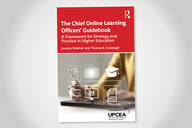You have /5 articles left.
Sign up for a free account or log in.
Two weeks have passed since I had the privilege of attending my third HAILStorm, this time hosted by CSU Channel Islands, a young institution with a big story to tell about the prize that lies at the intersection of academic innovation and upward mobility.
The first HAILStorm was hosted in January 2017 by my home institution, the University of Michigan and the second in Fall 2017 by Stanford University. HAILstorms one and two revealed an emergent network hungry for new connections. HAILStorm three, lightly structured by design, and featuring representatives from a range of institutions that reflect the diversity of the US higher education system, yielded shared interests worthy of pursuit. We pursue these shared interests while carefully establishing a new network that resists unnecessary structure.
As a community of academic innovation leaders grows, the informal nature of these occasional huddles continues to be a feature, not a bug. Yet convergence around several emerging themes suggests an opportunity to turn from new connections to collaborative action.
A new team is discovering its identity.
This blogpost goes live roughly twenty minutes before tipoff as the University of Michigan men’s basketball team plays for the NCAA national championship. I’m not a casual college basketball fan so it’s not lost on me that there is something special about this particular Michigan team. As I went through my various pre-game March Madness superfan rituals this weekend, I couldn’t help but think about the parallels between this team and an emerging group of HAILstormers.
Michigan’s men’s basketball coach John Beilein may have said it best in his pre-game press conference when asked about having success with lightly recruited players, "We aren't amassing talent. We're building a team... it's about development". Nearly all of the HAILStorm participants I spoke with in Camarillo talked of teams and new models for professional development that would enable academic innovation at a scale we know to be necessary. Building effective teams in the new era of academic innovation is a continuous effort for leaders of a growing number of units established to create catalysts for reimagining higher education.
Or perhaps it was the warm-up t-shirts Michigan players wore for much of the season which distill commitment to a simple mantra, “do more say less.” New academic innovation units around the country are turning ideas into action. They are talking less and enabling more. Thought partnership through exemplary service. Faculty innovators and student creators come to our units to partner, to do, to learn, to iterate. But ‘say less’ doesn’t mean ‘say nothing’. We have to tell stories along the way and do so with data wherever possible. Importantly though, we occasionally need to take smart risks before the data exists.
Those following this Michigan basketball team also notice something different about the style of play as compared with prior seasons. Coach Beilein has long been hailed as an offensive genius. But this year’s team plays defense too - really good lock-down defense. This balance gives options in a game filled with uncertainty - more rotations, greater adaptability, built to set pace or react to it.
HAILstormers also live with great uncertainty. In fact, we’re charged by our institutions to help our constituents to become more comfortable living in a world where unpredictability is the norm. With uncertainty and change stipulated as persistent conditions, HAILstorm three discussions surfaced at least four areas of shared interest that suggest a pivot from new connections to collaborative action.
Equity and Innovation: First, HAILstormers are deeply committed to pursuing opportunities at the intersection of equity and academic innovation. Many of our institutions have made public commitments to diversity, equity, and inclusion. A consistent theme across our conversations was a desire to further entangle our academic R&D initiatives with goals for greater diversity, equity, and inclusion. Though many think we can and should set the bar even higher and establish targets for upward social and economic mobility.
A few days before HAILstorm three, University of Maryland, Baltimore County captured national attention (harder and harder to do in an attention economy) with the rarest of rare March Madness upsets. The sixteenth seed triumphed over a number one seed. College basketball fans frantically googled ‘UMBC’. But for those of us paying attention to trailblazers in innovation and equality, UMBC, like Georgia State and Arizona State, raises banners regularly when it comes to serving students who are most in need of access to higher education. We should contribute to a movement that values outcomes such as mobility when designating elite status in higher education.
Sustainable Models for Academic Innovation: Second, HAILstormers are exploring different scenarios that provide pathways to sustainability for our relatively new organizational models. The funding models, cost structures, and revenue streams for our organizational units vary dramatically. So too does the risk tolerance of our respective institutions. There is benefit to this group when we actively explore different approaches to sustainability and to share openly the relative success of different strategies and tactics. Our increasing comfort with sharing failures will benefit our institutions, our constituents, and a broader mix of higher education actors seeking to reimagine higher education.
Home-grown Innovation and Commercialization: Third, HAILstormers are designing new models for edtech commercialization. Many of our institutions are developing new technology to advance learning. We all know the extent of investment in edtech companies over the last decade. I hope this investment will continue. I also hope that institutions like those represented at the HAILstorm will continue to pursue different models of edtech development that puts great emphasis on developing tools with faculty and student users and thinking critically about privacy and learning analytics. Multiple approaches give us the best chance of dramatically improving access and mobility and of realizing true personalization at scale.
Building for the Future with Human Capital Development: Fourth, HAILstormers seek to close the human capital supply/demand mismatch in our emergent field. By higher education standards, many of our organizations have grown very quickly. Our collective demand for talented and positive problem solvers is currently outpacing supply. Ultimately, we will see the market correct itself but the HAILstormers agree that there is an opportunity to accelerate this shift. Most of my new colleagues at the HAILstorm have successfully recruited or developed talent to take on roles without precedent. We are learning quickly about the traits of academic innovation professionals and need to think creatively and collaboratively about how to expand the pool. Without solving for this particular problem, our work will remain boutique in the grand bazaar of higher education
There are many other shared interests that inspire action among this group. But this should give us plenty to pursue as we grow a community bound together by a shared commitment to advancing learning and inspiring positive impact through sustainable approaches to academic innovation.
A new team is discovering its identity. Back to doing more and saying less.
James DeVaney (@devaneygoblue) is the Associate Vice Provost for Academic Innovation at the University of Michigan where he leads the Office of Academic Innovation.




